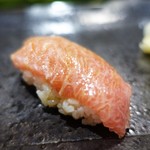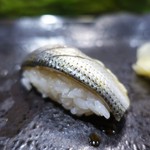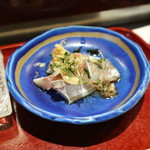
日本橋 寿司金
nihombashisushikin ◆ すしきん
3.31
Akebonobashi, Yotsuya-Sanchome
「Sushi」
30,000-39,999円
--
Opening hours: 17:30-21:00(L.O)
Rest time: Sunday
東京都新宿区荒木町9 上田ビル 1F
Photos
(20)




















Details
Reservation Info
can be reserved
Payment Method
Cards accepted
(JCB, AMEX, Diners)
Electronic money is not accepted.
Number of Seats
8 seats
(8 seats at counter)
Private Dining Rooms
None
Smoking and Non-Smoking
No smoking at the table
Parking
None
Facilities
Counter seats available
Drink
Sake and wine available
Comments
(20)
おおすみ
5.00
A traditional Edo-style sushi restaurant that faithfully preserves the techniques. It doesn't boast or act high-handed, and you can feel the atmosphere of a local sushi place while still experiencing top-notch flavors. The quality of the ingredients and the sushi rice are superb, and the techniques used bring out their full potential. The main style is omakase, with the option to choose your preferences. Recently, there has been an increase in pretentious sushi restaurants, making places like this one truly valuable. During this visit, we also ordered a bottle of wine and were offered a special bowl dish usually served to prominent figures, so the price was a bit higher, but typically it would be around 25,000 yen.




cocomicoco
4.20
★Gourmet Diary★ Araki-cho is full of famous restaurants! I heard that there used to be a TV station nearby, which made this area prosperous. This restaurant is a long-established sushi restaurant called "Oishinbo," which has been featured twice on TV for its special focus on tuna. As someone who tends to get scolded at sushi restaurants (for eating in a non-traditional way or being too stylish with friends), I was a bit nervous entering a place where the head chef is known for being particular. However, since we arrived early, we had the place to ourselves and the head chef and his son (?) kindly explained things and shared stories with us, making it a very enjoyable experience. The balance between the traditional charm of a long-established restaurant and the modern touch in the sushi and appetizers was perfect, allowing us to enjoy the meal until the end. In particular, the thinly sliced squid sushi, which seemed to be the head chef's idea, was a masterpiece in knife skills that was a delight to watch from the counter. If I have the chance, I would love to visit again (although the prices are on the higher side due to the quality of ingredients).




食いだおれリーマン
3.50
There is a shop in Yotsuya Sancho-me, where the owner seems to have appeared in "Oishinbo" and is also a purveyor to the Imperial Household Agency. The shop is famous for its tuna, and the nigiri sushi is large and extremely delicious! The prices are reasonable, but on the higher side. Instagram ID: kuidaore.8.




いのこり
3.80
Night omakase experience. The tuna seems to be their specialty. The nigiri sushi is nostalgic and comforting, but there seems to be a heartwarming tension between the head chef and his son. The son seems to be thinking of new ideas, while the head chef sticks to traditional knowledge. The tuna was excellent. Had 3-4 cups of sake with beer. The bill was surprisingly high! The atmosphere is like a local sushi place, but the prices are on the higher end. If they adjust the prices a bit, it could become quite popular. Looking forward to the next generation. A heartwarming father-son dynamic.

はらぺこかおり
3.70
Visited Sushikan in Araki-cho for dinner. The small restaurant is run by the master, his son, and maybe his wife. The master, despite his age, is passionate and dedicated to his sushi. We started with appetizers and then moved on to nigiri sushi. Both the beginning and the end were with tuna nigiri. The nigiri, made with natural ingredients, was full of love and care. The traditional Edo-style nigiri is not commonly seen these days. They also pay attention to the seaweed, making sure to properly bake it instead of just lightly toasting it. The conversation was lively, and we had a great time. Thank you for the wonderful meal.




IPPI
3.20
Sushi Kan's head chef is 88 years old! A true sushi restaurant can be found here. But it's just too expensive...




yukihara
3.50
The basic Edo-style sushi was amazing, especially the tuna was incredibly delicious!




Alexandria
3.00
On a white wooden counter, there was a lacquered pedestal. In a corner dish, there was wasabi and pickled ginger in sweet vinegar. Glass seed case. Premium beer.
- Tangzumi (appetizer): Karasumi (bottarga), hirame (flounder) cured with kelp from Misawa offshore driftnet fishing.
- Hoshi (dried food): Dried gourd from Tochigi prefecture. It has a sweet and crunchy texture.
- Wasabi Sushi: Sushi rice with grated water wasabi from Yuyama and simmered kelp, rolled with crispy seaweed from Tomiura. It's sweet and spicy, with a refreshing wasabi kick.
- Nigiri (hand-pressed sushi): The head chef is shaping large, firm nigiri with a generous amount of wasabi. The rice is slightly warm and vinegared.
- Bluefin Tuna: Akami (lean) cured, kamashita (fatty) cut, fin base.
- Small Fin: Kawazu (small fin) from Kisarazu offshore seine fishing, with a layer of abalone.
- Ark Shell: From Yura, with a chewy texture.
- Mahata (Japanese butterfish): From Bungo Strait, line-caught and ice-brined.
- Sea Urchin: From Hamanaka, Hokkaido, with a firm texture and natural sweetness.
- White Squid: From Tottori offshore squid fishing, with a sticky and sweet taste.
- Boiled Prawn: From Bungo Strait, boiled and sandwiched with abalone and grilled seaweed.
- Simmered Conger Eel: From Tsushima, with a soft and sweet taste.
- Tamago (egg): Thinly rolled with a hint of burn marks.
- Seafood Bowl: Sushi rice mixed with sea urchin, topped with flounder, mahata, tuna akami, toro, squid, ark shell, small fin, and sea urchin. A heavy and hearty meal, perfect for a good chat.
Thank you for the delicious meal. A gift of wasabi rolls and tekka maki. The wasabi rolls are a favorite, especially when the wasabi kick hits.
Avocado Man
3.80

スージー@love
4.00

僕が好きな東京の(お酒が)美味しいお店
3.30
The tuna is from Oma. It's delicious in a classic way. It's like good old sushi...
ru__co
5.00
You can enjoy authentic Edomae sushi here. The quality of the ingredients, the skill of the chef, and the service are all satisfying. The regular customers who frequent this restaurant are elegant and lovely. While it may be a bit pricey for regular visits, it is definitely worth another visit.
saepyon7
4.50
The skill of the sushi chef from Sushi Shucchou is truly remarkable ⚡ Delicious ⚡ The seaweed is also excellent ⚡ Don't miss the tamagoyaki ⚡ Enjoy the Edo-style spirit ⚡
coe_r
5.00
Visited on my birthday. The tuna here is amazing. You can taste various parts of the tuna, but the belly is especially delicious. Ate to my heart's content and ended up spending around 30,000 yen per person.
ハンゾウ
3.50
The sushi and rice at this sushi restaurant were delicious and truly authentic.
EATあいあい
3.50
The sushi restaurant in Yotsuya 3-chome. It was quite refreshing for me, who doesn't usually eat in this area! It started with marinated tuna, and I noticed that they use quite a bit of wasabi here. I like a lot of wasabi, so it wasn't a problem for me. It was delicious, but there wasn't anything particularly memorable about it, which was a bit disappointing. I wonder if modern sushi restaurants try to come up with one innovative menu item to make a lasting impression? Both in terms of performance and taste. (For example, steam coming out when you open it, or a special focus on the tamagoyaki.) Maybe they're trying not to stand out too much with exceptional flavors using an old-fashioned approach? Overall, it was delicious, but there wasn't a standout "this is better than anywhere else!" impression for me. The impression that stuck with me was "they use a lot of wasabi here!"




Inner_circle
4.50
It's been a while, Sushikan. This place is where I first started my sushi journey. It's located about a 7-minute walk from Yotsuya-Sanchome Station, near the famous yakiniku restaurant and motsuyaki Nonki. Although known for its tuna, the tuna here is truly delicious. The owner, who appeared in "Oishinbo," is now 81 years old but still going strong. The "Sunazuri" cut of tuna is a part named by the owner. The mix of Otoro, Chutoro, Sunazuri, and Kamatoro in a single piece is amazing. Each part is individually enjoyed before being mixed together into a unique piece. The highlight this time was the taste comparison of different ways of cutting the tuna belly. The taste really changes. The regular skin-side up piece, the one with the skin side up and down vertically, and the one with the skin side up and down horizontally. The taste gradually intensifies. I particularly enjoy the last one for its well-balanced flavor.




みるみんく
3.80
I heard that you can get a rare part of tuna here, so I decided to check it out. It's called Hiresita, and only about 7 pieces can be taken from one tuna. I requested it, but it depends on when it arrives. The omakase option includes a few appetizers and nigiri for around 20,000 yen. This time, I went with the omakase. Here's what I had:
- Tuna with wasabi
- Octopus with yuzu flavor
- Aomori flounder with salted kelp
- Swordfish from Miyagi
- Spear squid with sea urchin from Hokkaido
- Medium fatty tuna from Kishu
- Tuna cheek
- Natural amberjack from Oita
- Flounder with kelp
- Squid sashimi
- Ark shell
- Flounder sushi
- Sayori
- Torigai
- Sweet shrimp
- Cod milt
- Sea urchin
- Conger eel with seaweed
- Tuna roll
- Dried gourd
- Miso soup with fresh seaweed
The chef, who is 79 years old, prepared all the sushi. They are one of the few places in Tokyo where you can enjoy authentic Edo-style sushi. The sushi may have some rough edges, but the chef and his son were very attentive and provided a great learning experience. They are planning to move to Ginza before summer.




辛口リースリング
3.90
There is a sushi restaurant in Yotsuya 3-chome where you can enjoy a rare cut of tuna called "hagashi." I was invited to go there, and since I love tuna, I agreed. Three of us visited the restaurant, which had an old-fashioned atmosphere typical of a traditional sushi place. The interior was also reminiscent of a classic sushi restaurant, with only 8 seats at the counter. The restaurant has been run by the master and his son as a team. We had an omakase course with a variety of appetizers and nigiri sushi. The master said, "I will serve you fresh spring fish," as he and his son worked together to prepare grilled dishes and seasoned dishes. One of the appetizers I enjoyed was the salted kelp marinated flounder. It had a nice saltiness and a great texture. Moving on to the nigiri sushi, we started with three types of tuna. The hagashi tuna was indeed delicious, with a unique sweetness. The sushi rice was not too vinegary, and the saltiness was just right. They skillfully prepared each piece of sushi with a good pace. One standout was the ark shell, which was fresh and had a great texture. The master explained, "Ark shell retains a muddy smell if not washed properly after removing it from the shell." The white fish was not served raw here; it was boiled and prepared beforehand. It was a labor-intensive process. The spear squid was thinly sliced and then cut into thin strips before being shaped into nigiri. It was quite unique. The shirako (cod milt) was generously served on a bed of sushi rice that was baked in a dish. It was sweet and incredibly delicious, with a toasty flavor that paired well with the rice. The last piece of nigiri was a perfect way to end the meal. The conversation with the master and his son was lively, and we finished with miso soup with fresh seaweed. Unfortunately, they were unable to prepare the tamago (egg) due to timing issues. We had a bottle of beer and the bill came to around 24,000 yen. We were quite satisfied with our meal, and we learned that the restaurant will be relocating to Ginza this summer. We hope that the prices will not increase. Thank you for the wonderful meal.




ガレットブルトンヌ
4.20
I don't know how many sushi restaurants there are in Tokyo, but there are only about 5-6 shops that continue the traditional Edo-style techniques. One of them is here. The master, Mr. Akiyama, is 79 years old. He runs the shop with his son, and he still handles all the sushi making. I visited here because I wanted to try a rare cut of tuna called "hineta" that can only be found here. It can only be taken from one tuna, about 7 pieces in total. Even if you request it when making a reservation, there are times when it's not available. The shop has the appearance of a traditional sushi restaurant from the good old days. There are about 8 seats at the L-shaped counter, and there is also a refrigerated showcase. It was my first time visiting, but the master was very friendly and explained everything in detail. When I sat down, they were just preparing the tuna, and they showed me the "hineta." The master explained the traditional Edo-style work for each piece of sushi, and it was very educational. First, I had a plum wine soda, and then the meal began. Here is what I had that day: Tuna with wasabi, octopus from Kishu, flounder from Aomori sprinkled with kelp, skewered bonito from Miyagi, squid with sea urchin, medium fatty tuna, lean tuna, natural yellowtail from Oita, flounder marinated in kelp, squid sliced into 3 pieces, saury, shellfish from Mikawa, white fish with roe, natural shrimp, cod milt, sea urchin from Akkeshi, conger eel, and three kinds of tuna roll. The meal was finished with a shiny sun-dried gourd, a bowl of soup with new seaweed, and various other delicacies. The master demonstrated the essence of traditional Edo-style work while incorporating his own unique techniques throughout. It seems like he continues to evolve while maintaining the traditional skills. I can feel his philosophy of "things that don't change, things that change." I look forward to visiting again when the season changes.




Email Login